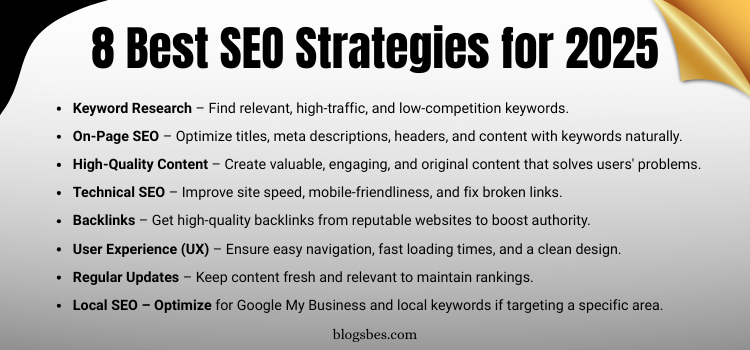SEO is changing fast. For years, an effective SEO strategy was all about Google. Rank high, get traffic, grow. Simple. But that simplicity is gone.
A new era is here:
Generative Engine Optimisation (GEO)
AI tools like ChatGPT, Perplexity, and Google’s AI Overviews reshape search. The way people find information is evolving, and also your SEO strategies.
Imagine your business. People aren’t just Googling anymore. They’re asking AI tools for answers. And those tools are delivering. Summaries, recommendations, and concise insights. Where does your business fit? If you’re not in those summaries, you’re invisible. GEO is about ensuring your SEO strategy isn’t just visible but dominant.
Start with the basics. Your website must rank in organic search. Without that foundation, AI tools won’t see you. But that’s just the beginning. To succeed, your SEO strategies must align with how AI-driven tools summarise and recommend. Structure matters, relevance matters, and authority matters.
EEAT (Experience, expertise, authoritativeness, trustworthiness)
AI tools favor content rooted in genuine knowledge. A passionate story. A specialist’s voice. Data that proves you know your field. Your SEO strategy can’t just aim to rank—it must aim to persuade. It plays a good role in ranking.

The Changing Landscape of SEO
SEO is changing fast, and we are entering a new era. If you think that just writing great content and building low-quality backlinks will get you the same results as before, you’re in for a tough time in the next 12 months.
There are two major themes you need to focus on for your SEO strategy:
The Rise of AI in Search
In the past, SEO was all about Google. People searched on Google, and that was the primary focus for SEO strategies.
Now, for the first time, we’re seeing real competition in search from tools like ChatGPT, Gemini and Perplexity. Your SEO strategy must adapt because people are searching in multiple places, including AI tools and Google’s own AI overviews.
This means businesses must ensure their products and services are discoverable wherever people search.
The Need for Two SEO Strategies
Previously, businesses had a single SEO strategy. Now, companies are increasingly building two SEO strategies:
- Top-of-Funnel SEO: Focuses on brand awareness and getting recommended in AI-driven searches.
- Bottom-of-Funnel SEO: Targets users who are ready to buy and drives them to your website.
We’ll break down how to implement these strategies effectively.
The Rise of Generative Engine Optimization (GEO)
One of the biggest shifts in search is Generative Engine Optimization (GEO). This refers to the techniques needed to get featured and recommended by generative AI tools like ChatGPT and Google’s AI overviews.
For example, a Google search for “Generative Engine Optimization Services” will show traditional web results, but AI-generated overviews push those results down. The techniques to rank in AI overviews differ from traditional SEO methods.
GEO is not just about Google’s AI overviews; it’s also about AI tools like ChatGPT. These tools actively recommend specific businesses, and with over a billion people using Google’s AI overviews by the end of 2024, businesses that adopt GEO now will have a first-mover advantage.
How to Optimize for Generative Engines
Most AI tools use some form of background web search to compile their results. This means your business must rank in traditional search results to increase its chances of being featured in AI-generated responses.
Key Steps to Rank in AI Overviews:
- Rank well in traditional Google search results.
- Get featured snippets and structured data recognition.
- Optimize content for long-tail, specific searches, as AI tools favour detailed and specific answers.
- Ensure your website is authoritative and frequently mentioned across the internet.
However, just ranking well in Google isn’t enough. There are additional specific optimizations needed to appear in AI-generated results.
AI Search and the Shift to Third-Party Authority
AI-powered tools like Perplexity conduct multi-step searches, compiling answers from various sources. This means third-party websites play a bigger role in SEO.
For example, a search for “best affordable skincare brands” in Perplexity shows results that reference multiple sources rather than just official brand websites.
The New SEO Game Plan:
- Identify third-party websites that AI tools rely on for recommendations.
- Ensure your brand, products, and services are prominently featured on these platforms.
- Use digital PR and content marketing to get coverage on trusted industry sites.
SEO for Bottom-of-Funnel Searches
Google struggles to differentiate businesses effectively, and AI-generated responses now often replace traditional top-of-funnel research.
For example, a search for “best business bank for mid-sized businesses” returns results primarily from third-party review sites, not from actual banks. If you’re a bank, you must focus on:
- Partnering with authoritative review sites to ensure your brand is included.
- Positioning your brand clearly with unique benefits beyond basic features.
Brand differentiation and positioning will become crucial in SEO moving forward.
The Future of SEO: Adapt or Fall Behind
Any SEO strategy that doesn’t incorporate Generative Engine Optimization (GEO) is missing a huge opportunity. AI overviews and AI-powered search are not the future—they are the present.
What This Means for Your SEO Strategy:
- Organic traffic may drop even if your SEO is excellent because AI answers eliminate the need for users to visit multiple websites.
- Top-of-funnel and middle-of-funnel research is now happening inside AI search tools, reducing visits to company websites.
- SEO strategies will need to be split into two approaches:
- Getting recommended in AI-driven search results.
- Driving bottom-of-funnel traffic to your site to convert users.
- Getting recommended in AI-driven search results.
I hope these SEO strategies will help you in driving healthy traffic and increase trust.
How do I rank a website on Google?
To rank a website on Google, focus on a mix of on-page, off-page, and technical SEO. Start with thorough keyword research to target relevant terms with high search volume and low competition.
How long does it take to rank a website on Google?
Ranking on Google can take anywhere from a few weeks to several months, depending on competition, keyword difficulty, content quality, and SEO efforts.
Does website speed affect Google rankings?
Yes, website speed is a crucial ranking factor. Optimizing images, using caching, and improving server response time can help boost speed and SEO performance.
Most Related

NADRA Jobs 2025 – Complete Guide to Career Opportunities, Departments & Eligibility

How to Earn 1000 rs Per Day Without Investment Online


